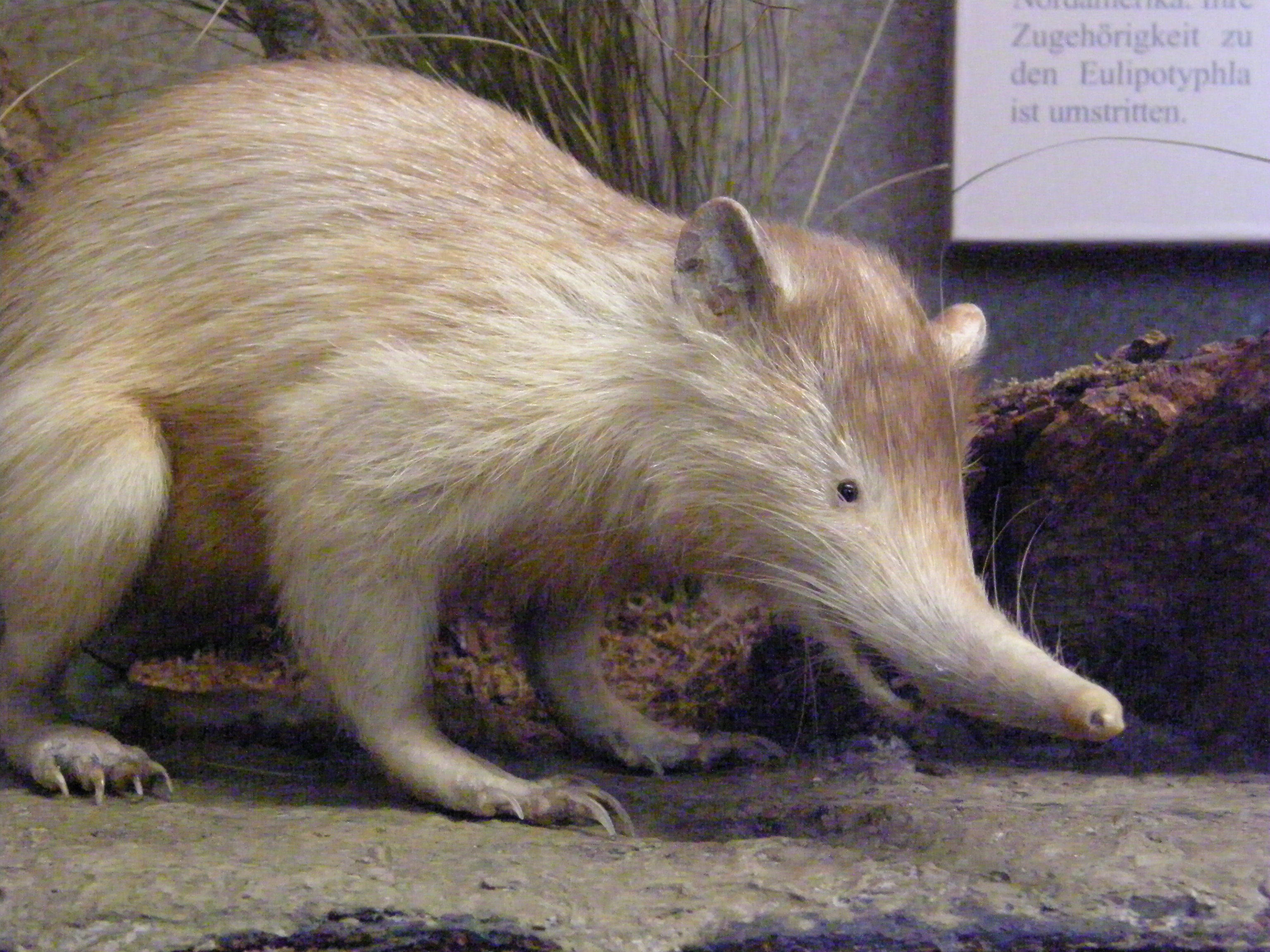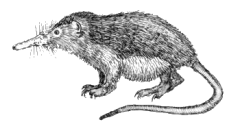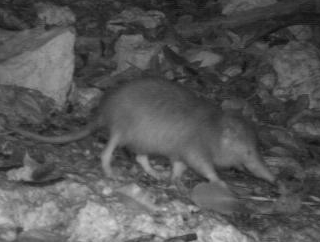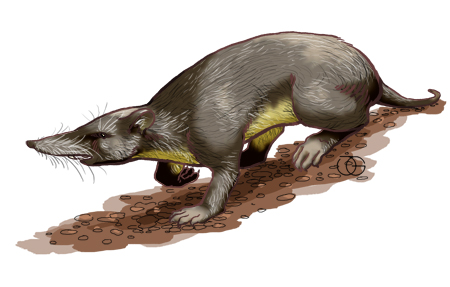Soricomorphs Of The Caribbean on:
[Wikipedia]
[Google]
[Amazon]
 The
The



www.iucnredlist.org
. Downloaded on June 20, 2015. * *MacPhee, R.D.E.; Flemming, C.; Lunde, D.P. (1999).
Last occurrence" of the Antillean insectivoran ''Nesophontes'': New radiometric dates and their interpretation
''American Museum Novitates'' 3261:1–20. * * * * * * {{DEFAULTSORT:Eulipotyphlans Of The Caribbean Mammals of the Caribbean Soricomorphs
 The
The Caribbean
The Caribbean (, ) ( es, El Caribe; french: la Caraïbe; ht, Karayib; nl, De Caraïben) is a region of the Americas that consists of the Caribbean Sea, its islands (some surrounded by the Caribbean Sea and some bordering both the Caribbean Se ...
region is home to two unique families of the mammal
Mammals () are a group of vertebrate animals constituting the class Mammalia (), characterized by the presence of mammary glands which in females produce milk for feeding (nursing) their young, a neocortex (a region of the brain), fur or ...
ian order Eulipotyphla
Eulipotyphla (, which means "truly fat and blind") is an order of mammals suggested by molecular methods of phylogenetic reconstruction, which includes the laurasiatherian members of the now-invalid polyphyletic order Lipotyphla, but not the afr ...
(incorporating the now defunct order Soricomorpha
Soricomorpha (from Greek "shrew-form") is a formerly used taxon within the class of mammals. In the past it formed a significant group within the former order Insectivora. However, Insectivora was shown to be polyphyletic and various new orders ...
), which also includes the hedgehog
A hedgehog is a spiny mammal of the subfamily Erinaceinae, in the eulipotyphlan family Erinaceidae. There are seventeen species of hedgehog in five genera found throughout parts of Europe, Asia, and Africa, and in New Zealand by introducti ...
s, gymnure
Gymnures, also called hairy hedgehogs or moonrats, are mammals belonging to the subfamily Galericinae, in the family Erinaceidae and the order Eulipotyphla. Gymnures resemble rats but are not closely related as they are not rodents; they are ...
s shrew
Shrews (family Soricidae) are small mole-like mammals classified in the order Eulipotyphla. True shrews are not to be confused with treeshrews, otter shrews, elephant shrews, West Indies shrews, or marsupial shrews, which belong to different fa ...
s, mole
Mole (or Molé) may refer to:
Animals
* Mole (animal) or "true mole", mammals in the family Talpidae, found in Eurasia and North America
* Golden moles, southern African mammals in the family Chrysochloridae, similar to but unrelated to Talpida ...
s and desman
The desman, a snouted and naked-tailed diving insectivore of the tribe Desmanini (also considered a subfamily, Desmaninae), belongs to one of two Eurasian species of the mole family, Talpidae.
This tribe consists of two monotypic genera of sem ...
s. Only one Caribbean family, that of the solenodon
Solenodons (from el, τέλειος , 'channel' or 'pipe' and el, ὀδούς , 'tooth') are venomous, nocturnal, burrowing, insectivorous mammals belonging to the family Solenodontidae . The two living solenodon species are the Cuban solen ...
s, is still extant; the other, Nesophontidae
''Nesophontes'', sometimes called West Indies shrews, is the sole genus of the extinct, monotypic mammal family Nesophontidae in the order Eulipotyphla. These animals were small insectivores, about 5 to 15 cm long, with a long slender snout ...
, became extinct within the last few centuries.
For the purposes of this article, the "Caribbean" includes all islands in the Caribbean Sea
The Caribbean Sea ( es, Mar Caribe; french: Mer des Caraïbes; ht, Lanmè Karayib; jam, Kiaribiyan Sii; nl, Caraïbische Zee; pap, Laman Karibe) is a sea of the Atlantic Ocean in the tropics of the Western Hemisphere. It is bounded by Mexico ...
(except for small islets close to the mainland) and the Bahamas
The Bahamas (), officially the Commonwealth of The Bahamas, is an island country within the Lucayan Archipelago of the West Indies in the Atlantic Ocean, North Atlantic. It takes up 97% of the Lucayan Archipelago's land area and is home to ...
, Turks and Caicos Islands
The Turks and Caicos Islands (abbreviated TCI; and ) are a British Overseas Territory consisting of the larger Caicos Islands and smaller Turks Islands, two groups of tropical islands in the Lucayan Archipelago of the Atlantic Ocean and n ...
, and Barbados
Barbados is an island country in the Lesser Antilles of the West Indies, in the Caribbean region of the Americas, and the most easterly of the Caribbean Islands. It occupies an area of and has a population of about 287,000 (2019 estimate). ...
, which are not in the Caribbean Sea but biogeographically
Biogeography is the study of the species distribution, distribution of species and ecosystems in geography, geographic space and through evolutionary history of life, geological time. Organisms and biological community (ecology), communities of ...
belong to the same Caribbean bioregion
The Caribbean bioregion is a biogeographic region that includes the islands of the Caribbean Sea and nearby Atlantic islands, which share a fauna, flora and mycobiota distinct from surrounding bioregions.
Geography
The Caribbean bioregion, as desc ...
.
Overview
About fifteen species of Caribbean eulipotyphlans are known to have existed during theQuaternary
The Quaternary ( ) is the current and most recent of the three periods of the Cenozoic Era in the geologic time scale of the International Commission on Stratigraphy (ICS). It follows the Neogene Period and spans from 2.58 million years ...
, but not all ''Nesophontes'' species are universally accepted as valid.Hutterer, 2005, p. 220 However, most of these, including all ''Nesophontes'', are now extinct; the Cuban solenodon
The Cuban solenodon or ''almiquí'' (''Atopogale cubana'') is a small, furry, shrew-like mammal endemic to mountainous forests on Cuba. It is the only species in the genus ''Atopogale''. An elusive animal, it lives in burrows and is only active ...
is classified as Endangered
An endangered species is a species that is very likely to become extinct in the near future, either worldwide or in a particular political jurisdiction. Endangered species may be at risk due to factors such as habitat loss, poaching and inva ...
, while the Hispaniolan solenodon
The Hispaniolan solenodon (''Solenodon paradoxus'') is a small, furry, shrew-like mammal endemic to the Caribbean island of Hispaniola (in the Dominican Republic and Haiti). Like other solenodons, it is a venomous, insect-eating animal that liv ...
is classified as Least Concern
A least-concern species is a species that has been categorized by the International Union for Conservation of Nature (IUCN) as evaluated as not being a focus of species conservation because the specific species is still plentiful in the wild. T ...
.
The interrelationships of the two Caribbean genera remain unclear. Similarities in skull
The skull is a bone protective cavity for the brain. The skull is composed of four types of bone i.e., cranial bones, facial bones, ear ossicles and hyoid bone. However two parts are more prominent: the cranium and the mandible. In humans, the ...
morphology have led some to propose close affinities between the two, but differences in characters of the teeth are evidence against a close relationship. DNA evidence suggests that solenodons are a sister group to a clade of shrews, moles, and erinaceid
Erinaceidae is a family in the order Eulipotyphla, consisting of the hedgehogs and moonrats. Until recently, it was assigned to the order Erinaceomorpha, which has been subsumed with the paraphyletic Soricomorpha into Eulipotyphla. Eulipotyphl ...
s, with a molecular clock
The molecular clock is a figurative term for a technique that uses the mutation rate of biomolecules to deduce the time in prehistory when two or more life forms diverged. The biomolecular data used for such calculations are usually nucleoti ...
, providing evidence that the split from the other families occurred in the Cretaceous
The Cretaceous ( ) is a geological period that lasted from about 145 to 66 million years ago (Mya). It is the third and final period of the Mesozoic Era, as well as the longest. At around 79 million years, it is the longest geological period of th ...
period, late in the Mesozoic
The Mesozoic Era ( ), also called the Age of Reptiles, the Age of Conifers, and colloquially as the Age of the Dinosaurs is the second-to-last era of Earth's geological history, lasting from about , comprising the Triassic, Jurassic and Cretaceo ...
era. How they came to the Antilles is unknown; they may have arrived either via overwater dispersal or via some sort of land bridge from North America, South America, or even Africa, and ''Nesophontes'' and solenodons may have different origins.
The genera of Caribbean eulipotyphlans are classified as follows:
*Order Eulipotyphla
**Family Nesophontidae
''Nesophontes'', sometimes called West Indies shrews, is the sole genus of the extinct, monotypic mammal family Nesophontidae in the order Eulipotyphla. These animals were small insectivores, about 5 to 15 cm long, with a long slender snout ...
: ''Nesophontes
''Nesophontes'', sometimes called West Indies shrews, is the sole genus of the extinct, monotypic mammal family Nesophontidae in the order Eulipotyphla. These animals were small insectivores, about 5 to 15 cm long, with a long slender snout ...
''
**Family Solenodontidae
Solenodons (from el, τέλειος , 'channel' or 'pipe' and el, ὀδούς , 'tooth') are venomous, nocturnal, burrowing, insectivorous mammals belonging to the family Solenodontidae . The two living solenodon species are the Cuban solen ...
: ''Solenodon
Solenodons (from el, τέλειος , 'channel' or 'pipe' and el, ὀδούς , 'tooth') are venomous, nocturnal, burrowing, insectivorous mammals belonging to the family Solenodontidae . The two living solenodon species are the Cuban solen ...
'' and '' Atopogale''
**Unidentified genus
Cuba

Cuba
Cuba ( , ), officially the Republic of Cuba ( es, República de Cuba, links=no ), is an island country comprising the island of Cuba, as well as Isla de la Juventud and several minor archipelagos. Cuba is located where the northern Caribbea ...
, the largest of the Antilles
The Antilles (; gcf, label=Antillean Creole, Antiy; es, Antillas; french: Antilles; nl, Antillen; ht, Antiy; pap, Antias; Jamaican Patois: ''Antiliiz'') is an archipelago bordered by the Caribbean Sea to the south and west, the Gulf of Mex ...
, also has the largest inventory of eulipotyphlans, including five members of ''Nesophontes'' and two solenodons.
*†''Nesophontes major
The greater Cuban nesophontes (''Nesophontes major'') is an extinct species of eulipotyphlan that was native to Cuba
Cuba ( , ), officially the Republic of Cuba ( es, República de Cuba, links=no ), is an island country comprising the isl ...
'' is known from cave deposits of uncertain age.Hutterer, 2005, p. 220-221
*†''Nesophontes micrus
The western Cuban nesophontes (''Nesophontes micrus'') is an extinct species of mammal in the family Nesophontidae. It was found on Cuba
Cuba ( , ), officially the Republic of Cuba ( es, República de Cuba, links=no ), is an island count ...
'', the most widespread and large ''Nesophontes'', is known from a single mandible dated to the 14th century CE that was found on the surface of a cave deposit together with ''Rattus'', suggesting recent survival.Hutterer, 2005, p. 222
*†'' Solenodon arredondoi'' is known from Late Pleistocene deposits in western Cuba.
*'' Atopogale cubana'', the only surviving Cuban solenodon, has been confirmed only from eastern Cuba as a living animal, but there are several fossil records in the western part of the island.
*Some fossil cave samples from several localities represent solenodons that are larger than ''A. cubana'', but too small for ''S. arredondoi''. They have been identified as ''Solenodon'' cf. ''cubanus''.
Isla de la Juventud
Isla de la Juventud
Isla de la Juventud (; en, Isle of Youth) is the second-largest Cuban island (after Cuba's mainland) and the seventh-largest island in the West Indies (after mainland Cuba itself, Hispaniola, Jamaica, Puerto Rico, Trinidad, and Andros Islan ...
is a large island south of Cuba.
*†''Nesophontes micrus
The western Cuban nesophontes (''Nesophontes micrus'') is an extinct species of mammal in the family Nesophontidae. It was found on Cuba
Cuba ( , ), officially the Republic of Cuba ( es, República de Cuba, links=no ), is an island count ...
'' has been recorded from the island.
Cayman Islands
Two extinctundescribed species
In taxonomy, an undescribed taxon is a taxon (for example, a species) that has been discovered, but not yet formally described and named. The various Nomenclature Codes specify the requirements for a new taxon to be validly described and named. U ...
of ''Nesophontes'' are known from several cave deposits on the Cayman Islands
The Cayman Islands () is a self-governing British Overseas Territory—the largest by population in the western Caribbean Sea. The territory comprises the three islands of Grand Cayman, Cayman Brac and Little Cayman, which are located to the ...
, a British archipelago south of Cuba. The two are similar in morphology, but the species from Grand Cayman
Grand Cayman is the largest of the three Cayman Islands and the location of the territory's capital, George Town. In relation to the other two Cayman Islands, it is approximately 75 miles (121 km) southwest of Little Cayman and 90 miles ( ...
is larger than the one from Cayman Brac
Cayman Brac is an island that is part of the Cayman Islands. It lies in the Caribbean Sea about north-east of Grand Cayman and east of Little Cayman. It is about long, with an average width of . Its terrain is the most prominent of the thre ...
. They are closely related to each other and to the Cuban–Hispaniolan species ''N. micrus''. The oldest record is from the latest Pleistocene, but they probably arrived there earlier in the Pleistocene, if not in the Pliocene. In the youngest layers of several deposits, ''Nesophontes'' is found together with introduced ''Rattus
''Rattus'' is a genus of muroid rodents, all typically called rats. However, the term rat can also be applied to rodent species outside of this genus.
Species and description
The best-known ''Rattus'' species are the black rat (''R. rattus'') ...
'', indicating that its extinction occurred relatively recently.
Hispaniola
Hispaniola
Hispaniola (, also ; es, La Española; Latin and french: Hispaniola; ht, Ispayola; tnq, Ayiti or Quisqueya) is an island in the Caribbean that is part of the Greater Antilles. Hispaniola is the most populous island in the West Indies, and th ...
is the second largest of the Antilles. It is divided into Haiti
Haiti (; ht, Ayiti ; French: ), officially the Republic of Haiti (); ) and formerly known as Hayti, is a country located on the island of Hispaniola in the Greater Antilles archipelago of the Caribbean Sea, east of Cuba and Jamaica, and ...
and the Dominican Republic
The Dominican Republic ( ; es, República Dominicana, ) is a country located on the island of Hispaniola in the Greater Antilles archipelago of the Caribbean region. It occupies the eastern five-eighths of the island, which it shares wit ...
.
*†''Nesophontes hypomicrus
The Atalaye nesophontes (''Nesophontes hypomicrus'') is an extinct species of mammal in the family Nesophontidae. It was endemic to Hispaniola in the Caribbean (in both Haiti and the Dominican Republic), and is only known from fossil
A fo ...
'' has been found together with ''Rattus'' and remains from a cave in the Dominican Republic have been dated to the 13th century CE.
*†''Nesophontes micrus
The western Cuban nesophontes (''Nesophontes micrus'') is an extinct species of mammal in the family Nesophontidae. It was found on Cuba
Cuba ( , ), officially the Republic of Cuba ( es, República de Cuba, links=no ), is an island count ...
'' has also been recorded from Hispaniola.
*†''Nesophontes paramicrus
The St. Michel nesophontes (''Nesophontes paramicrus'') is an extinct species of mammal in the family Nesophontidae. It was endemic to Hispaniola (today Haiti and the Dominican Republic).
Taxonomy
A phylogenetic study in 2016, based on DNA ...
'' has been found together with remains of ''Rattus''; some bones from a cave in Haiti have been dated to the 14th century CE.
*†''Nesophontes zamicrus
The Haitian nesophontes (''Nesophontes zamicrus'') is an extinct species of mammal in the family Nesophontidae. It was endemic to Hispaniola in the Caribbean (in both the Dominican Republic and Haiti
Haiti (; ht, Ayiti ; French: ), offic ...
'' has been found together with ''Rattus''; some remains have been radiocarbon-dated to the 13th century CE.
*†''Solenodon marcanoi
Marcano's solenodon (''Solenodon marcanoi'') is an extinct species of mammal in the family Solenodontidae known only from skeletal remains found on the island of Hispaniola (today the Dominican Republic and Haiti).
Etymology
The specific ep ...
'' is known from late Quaternary fossil deposits in southern Haiti and the southwestern Dominican Republic.
*'' Solenodon paradoxus'', the Hispaniolan solenodon (one of two extant solenodons), is known both as a living animal and from fossil deposits throughout much of the island, except for northern Haiti. Separate subspecies
In biological classification, subspecies is a rank below species, used for populations that live in different areas and vary in size, shape, or other physical characteristics (morphology), but that can successfully interbreed. Not all species ...
occur in the northern (''S. p. paradoxus'') and southern highlands (''S. p. woodi'').
*Some chest vertebrae and associated ribs of a mammal, probably a solenodontid, have been found in amber
Amber is fossilized tree resin that has been appreciated for its color and natural beauty since Neolithic times. Much valued from antiquity to the present as a gemstone, amber is made into a variety of decorative objects."Amber" (2004). In Ma ...
in the Dominican Republic. These are probably not older than the late Oligocene
The Oligocene ( ) is a geologic epoch of the Paleogene Period and extends from about 33.9 million to 23 million years before the present ( to ). As with other older geologic periods, the rock beds that define the epoch are well identified but the ...
. The animal would have been about the size of ''Nesophontes'', with an estimated body mass of .MacPhee and Grimaldi, 1996
Gonâve
Gonâve is an island off western Hispaniola, part ofHaiti
Haiti (; ht, Ayiti ; French: ), officially the Republic of Haiti (); ) and formerly known as Hayti, is a country located on the island of Hispaniola in the Greater Antilles archipelago of the Caribbean Sea, east of Cuba and Jamaica, and ...
.
*†''Nesophontes hypomicrus
The Atalaye nesophontes (''Nesophontes hypomicrus'') is an extinct species of mammal in the family Nesophontidae. It was endemic to Hispaniola in the Caribbean (in both Haiti and the Dominican Republic), and is only known from fossil
A fo ...
''
*'' Solenodon paradoxus'', the extant Hispaniolan solenodon, is known from a recent fossil deposit on Gonâve, but there are currently no known solenodon populations there.Ottenwalder, 2001, fig. 16
Puerto Rico

Puerto Rico
Puerto Rico (; abbreviated PR; tnq, Boriken, ''Borinquen''), officially the Commonwealth of Puerto Rico ( es, link=yes, Estado Libre Asociado de Puerto Rico, lit=Free Associated State of Puerto Rico), is a Caribbean island and Unincorporated ...
is the smallest and easternmost of the Greater Antilles.
*†''Nesophontes edithae
The Puerto Rican nesophontes (''Nesophontes edithae''), or Puerto Rican shrew, is an extinct eulipotyphlan endemic to Puerto Rico.
It is believed that the animal was never observed by Europeans. Contemporary fossils with indigenous artefacts a ...
'', a large ''Nesophontes'', has been recorded from an Amerindian site, and dated to about 1000 CE.
Vieques
Vieques
Vieques (; ), officially Isla de Vieques, is an island and municipality of Puerto Rico, in the northeastern Caribbean, part of an island grouping sometimes known as the Spanish Virgin Islands. Vieques is part of the Commonwealth of Puerto Rico, ...
is the largest island associated with Puerto Rico; it is located east of the main island.
*†''Nesophontes edithae
The Puerto Rican nesophontes (''Nesophontes edithae''), or Puerto Rican shrew, is an extinct eulipotyphlan endemic to Puerto Rico.
It is believed that the animal was never observed by Europeans. Contemporary fossils with indigenous artefacts a ...
'', a Puerto Rican ''Nesophontes'', has been recorded from a kitchen midden on Vieques.Ottenwalder, 2001, p. 253
Saint John
Saint John is one of the main islands of the northernUnited States Virgin Islands
The United States Virgin Islands,. Also called the ''American Virgin Islands'' and the ''U.S. Virgin Islands''. officially the Virgin Islands of the United States, are a group of Caribbean islands and an unincorporated and organized territory ...
.
*†''Nesophontes edithae
The Puerto Rican nesophontes (''Nesophontes edithae''), or Puerto Rican shrew, is an extinct eulipotyphlan endemic to Puerto Rico.
It is believed that the animal was never observed by Europeans. Contemporary fossils with indigenous artefacts a ...
'' is known from archeological material.MacPhee et al., 1999, p. 7
Saint Thomas
Saint Thomas is one of the main islands of the northernUnited States Virgin Islands
The United States Virgin Islands,. Also called the ''American Virgin Islands'' and the ''U.S. Virgin Islands''. officially the Virgin Islands of the United States, are a group of Caribbean islands and an unincorporated and organized territory ...
.
*†''Nesophontes edithae
The Puerto Rican nesophontes (''Nesophontes edithae''), or Puerto Rican shrew, is an extinct eulipotyphlan endemic to Puerto Rico.
It is believed that the animal was never observed by Europeans. Contemporary fossils with indigenous artefacts a ...
'' is known from archeological material.
See also
*Island biogeography Insular biogeography or island biogeography is a field within biogeography that examines the factors that affect the species richness and diversification of isolated natural communities. The theory was originally developed to explain the pattern of ...
* Extinction
Extinction is the termination of a kind of organism or of a group of kinds (taxon), usually a species. The moment of extinction is generally considered to be the death of the last individual of the species, although the capacity to breed and ...
* List of North American eulipotyphlans
* List of Mexican eulipotyphlans
* List of Central American eulipotyphlans
* List of South American eulipotyphlans
References
Literature cited
* *IUCN 2008. ''IUCN Red List of Threatened Species''. Version 2015.1.www.iucnredlist.org
. Downloaded on June 20, 2015. * *MacPhee, R.D.E.; Flemming, C.; Lunde, D.P. (1999).
Last occurrence" of the Antillean insectivoran ''Nesophontes'': New radiometric dates and their interpretation
''American Museum Novitates'' 3261:1–20. * * * * * * {{DEFAULTSORT:Eulipotyphlans Of The Caribbean Mammals of the Caribbean Soricomorphs